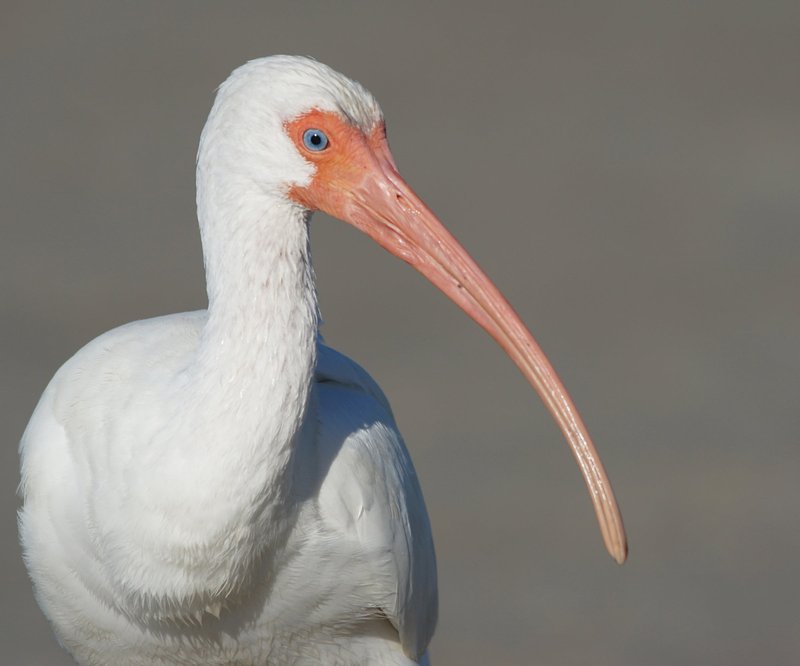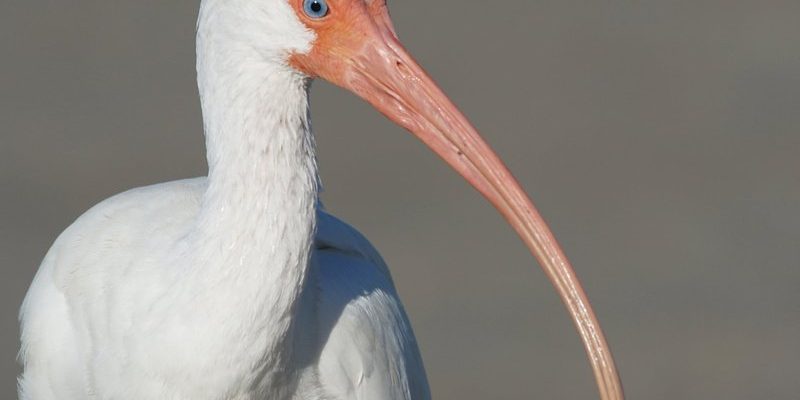
The White Ibis is a captivating bird, often seen wading through wetlands and along shorelines in search of food. With its striking white feathers and long, curved bill, this bird is not just another pretty face; it plays an essential role in its ecosystem. You might find them in flocks, gracefully moving through shallow waters, and it’s hard not to be drawn in by their unique appearance and charming behavior.
Imagine strolling along a tranquil marsh, the sun glistening off the water, and you notice a group of these elegant birds diligently probing the mud with their long bills. There’s something almost poetic about their movements. They embody the beauty and functionality of nature, and understanding more about the White Ibis can deepen your appreciation for this amazing creature.
Physical Characteristics
The White Ibis is known for its distinctive all-white plumage, which can sometimes appear almost dazzling in the sunlight. These birds are medium-sized, standing about 24 to 28 inches tall. Their wings, when spread, can reach up to 38 inches, making them quite impressive in flight. A notable feature is their long, downward-curved bill, which is perfectly adapted for foraging in mud and shallow waters.
Their legs are long and slender, ideal for wading through various water depths. The birds have a slight pink hue to their skin, particularly noticeable near the face and legs, especially during breeding season when they might display vibrant colors to attract mates. This combination of features not only makes them visually striking but is also functional, allowing them to thrive in their preferred habitats.
Habitat and Range
White Ibises are commonly found in a variety of wetland habitats, including marshes, swamps, and coastal areas. They thrive in areas where food is abundant, such as wetlands with shallow waters, where they can easily probe for crustaceans, insects, and small fish. Their range primarily includes parts of North America, Central America, and the Caribbean, with a notable concentration along the Gulf and Atlantic coasts.
Here’s the thing: while they prefer warm climates, their migratory behavior can lead them to move to different regions depending on food availability. During the breeding season, which varies based on location, they often nest in colonies close to water, perched in trees or shrubs. Their nesting sites can be so dense that they look like living islands amidst the wetlands.
| Size: | 24-28 inches tall |
| Wingspan: | 38 inches |
| Weight: | 1.5-2.5 pounds |
| Diet: | Crustaceans, insects, small fish |
| Lifespan: | Up to 16 years |
| Habitat: | Wetlands, marshes, coastal areas |
Diet and Feeding Habits
The diet of the White Ibis primarily consists of small aquatic creatures. They are experts in foraging, using their long bills to probe through mud and shallow waters to uncover hidden delicacies. Often, they’ll be seen moving in unison, a behavior that not only aids in locating food but also helps them keep an eye out for predators. It’s fascinating to watch them as they tilt their heads, carefully searching for a tasty meal.
In addition to crustaceans and insects, White Ibises are also known to eat small frogs and fish. Their feeding strategy is quite adaptive; they can adjust their diet based on the seasonal availability of food. This flexibility is crucial for their survival and is a testament to their resilience as a species.
Breeding and Nesting
During the breeding season, which typically occurs between spring and summer, White Ibises engage in elaborate courtship displays. Males will show off their plumage and perform various rituals to attract females. Once a pair forms, they often create a nest close to their feeding grounds, usually in trees or shrubs that provide some cover.
Both parents are involved in building the nest, which is made from sticks and vegetation. After laying 2 to 5 eggs, the incubation period lasts about 21 to 28 days. Once the chicks hatch, both parents continue to care for them, ensuring they receive the right food and protection from threats. It’s heartwarming to think about how this pair works together, ensuring the survival of the next generation.
Behavior and Social Structure
White Ibises are highly social birds, often found in flocks that can range from a few dozen to several hundred individuals. Their social structures are fascinating; they communicate with each other through a series of croaks and honks, which can be heard when they are foraging or nesting. Their group behaviors not only help in finding food but also offer protection from predators.
These birds are known to engage in cooperative breeding, where non-breeding individuals help care for the chicks. This behavior enhances the survival rates of the young, as more eyes can spot potential dangers. It’s a beautiful example of community and teamwork in the animal kingdom, emphasizing the bond that forms within their flocks.
Conservation Status
The White Ibis is currently not considered endangered, but like many wildlife species, they face threats from habitat loss and environmental changes. Wetland destruction due to urban expansion and agriculture can significantly impact their breeding and feeding grounds. Moreover, pollution in water bodies affects the availability of their food sources.
Conservation efforts are essential to ensure that these lovely birds continue to thrive in their natural habitats. Many organizations are actively working to protect wetlands and restore ecosystems, which can benefit not just the White Ibis but countless other species that depend on these vital environments.
Interesting Facts
Did you know that the White Ibis has been a symbol of good fortune in some cultures? In ancient Egypt, they were associated with the god Thoth, representing wisdom and knowledge. This connection to mythology highlights how humans have long been fascinated by the beauty and grace of these birds.
Another fun fact: White Ibises are often seen performing a synchronized feeding dance. As they probe the ground for food, you might notice them moving in perfect harmony, a remarkable sight that showcases their social nature and instinctive behaviors. This dance is not just entertaining; it’s also effective in finding food more efficiently.
FAQ
What do White Ibises eat in the wild?
White Ibises primarily feed on small aquatic organisms, including crustaceans, insects, frogs, and small fish. They use their long, curved bills to probe through mud and shallow water, making them highly effective foragers. Their diet adapts to seasonal changes, ensuring they can find sustenance year-round.
Where can I see White Ibises in the wild?
You can find White Ibises in various wetlands, marshes, and coastal regions across North America, Central America, and the Caribbean. They are often seen in groups, foraging along shorelines or wading through shallow water. Local parks, nature reserves, and wildlife refuges that feature wetland habitats are great places to observe these birds.
How do White Ibises care for their young?
Once the female White Ibis lays her eggs, both parents take turns incubating them for about 21 to 28 days. After the chicks hatch, the parents continue to care for them, feeding them and protecting them from potential threats. Interestingly, non-breeding individuals may also help care for the young, which increases their chances of survival.
Are White Ibises migratory birds?
While some populations of White Ibises are migratory, others are resident birds that remain in their breeding territories year-round. Their migratory patterns often depend on food availability and environmental conditions. During migrations, they may travel considerable distances in search of optimal feeding grounds.
What threats do White Ibises face?
White Ibises are threatened by habitat loss, primarily due to wetland destruction from urban development and agriculture. Pollution in water bodies can also impact their food sources, making conservation efforts vital for their survival. Protecting wetland habitats is crucial for ensuring these birds can thrive.
How long do White Ibises live?
In the wild, White Ibises can live up to 16 years, although their lifespan can be influenced by environmental factors and threats. With proper care and a suitable habitat, they can reach their full lifespan, contributing to their population’s health and stability.
Do White Ibises have any predators?
Yes, White Ibises face several natural predators, including birds of prey, raccoons, and snakes, especially when they are nesting. The young chicks are particularly vulnerable to predation. Their social structure and foraging behavior help minimize the risk of being attacked, as they often forage in groups.
What is the significance of White Ibises in culture?
In various cultures, particularly in ancient Egypt, the White Ibis was associated with wisdom and knowledge. This spiritual connection highlights the fascination humans have with these birds, often symbolizing good fortune and balance in nature. Their striking appearance and social behaviors contribute to their mythological significance.
How can I help protect White Ibises?
One way to help protect White Ibises is by supporting conservation organizations focused on wetland preservation. You can also educate others about the importance of protecting natural habitats and participate in local clean-up efforts to prevent pollution in waterways. Every small action contributes to the conservation of these beautiful birds and their ecosystems.
What are some unique behaviors of White Ibises?
White Ibises exhibit fascinating social behaviors, such as synchronized feeding and cooperative breeding. They often forage in groups, which not only makes finding food easier but also provides safety in numbers. Their unique courtship displays during the breeding season are also a highlight of their behavior, showcasing their social and mating rituals.

